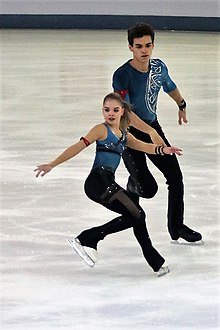포스파티딜이노시톨4,5-이인산
Phosphatidylinositol 4,5-bisphosphate | |
| 이름 | |
|---|---|
| IUPAC 이름 1,2-디아실-sn-글리세로-3-포스포-(1-D-묘이노시톨4,5-이인산) | |
| 식별자 | |
3D 모델(JSmol) | |
| 켐스파이더 | |
PubChem CID | |
CompTox 대시보드 (EPA ) | |
| |
| |
| 특성. | |
| 잘라내다4780193 | |
| 몰 질량 | 1042.05 g/140 |
달리 명시되지 않은 한 표준 상태(25°C[77°F], 100kPa)의 재료에 대한 데이터가 제공됩니다. | |
PIP 또는 PI(4,5)P로도22 알려진 포스파티딜리노시톨 4,5-이인산 또는 PtdIns(4,5)P는2 세포막의 작은 인지질 성분이다.PtdIns(4,5)P는2 다수의 중요한 시그널링 [1]단백질의 기질인 플라즈마막에서 농축된다.
PIP는2 주로 PI(4)P로부터의 I형 포스파티딜이노시톨 4-인산5-키나아제에 의해 형성된다.메타조안에서 PIP는2 PI([2]5)P로부터의 II형 포스파티딜이노시톨5-인산 4-키나아제에 의해서도 형성될 수 있다.
PIP의2 지방산은 종과 조직에 따라 다양하지만, 가장 일반적인 지방산은 위치 1의 스테아린산, [3]2의 아라키돈산이다.
시그널링 패스
PIP는2 PIP 회로, PI3K 신호 전달 및 PI5P 대사를 [4]포함한 많은2 세포 신호 전달 경로의 일부이다.최근에는 기능을 알 수 없는 핵에서[5] 발견되고 있습니다.
기능들
세포막 주변 세포골격 역학
PIP는2 F-actin 조절 [6]단백질과의 직접 결합을 통해 필라멘트 액틴(F-actin)의 구성, 중합 및 분기를 조절합니다.
세포내막증 및 세포외막증
포스포이노시티드(PIs)(특히 PI(4,5)P2)가 세포외 공정에서 중요하다는 것을 나타내는 최초의 증거는 1990년이었다.Emberhard 등은 디지토닌 퍼머빌리제 C의 디지토닌화 크로마핀 세포에 PI 특이적 포스포리파아제 C를 적용하면 PI 수치가 감소하고 칼슘에 의해 유발되는 엑소사이토시스가 억제된다는 것을 발견했다.이러한 세포외저해는 ATP의존성 단계에서 선호되었으며, 이는 분비에 PI 기능이 필요함을 나타낸다.이후 연구는 포스파티딜이노시톨 전달 단백질 [8]및 ATP 의존적인 방식으로 투과성 세포 배양에서 PI(4,5)P2 복원을 매개하는 포스포이노시톨-4-모노포스파타아제 5 키나아제 I i (PIPK))[9]와 같이 이 단계에서 필요한 관련 단백질을 확인했습니다.이후 연구에서 PI(4,5)P2 특이 항체는 세포외증을 강하게 억제하여 LDCV(Large Density Core vessicle) 세포외증 과정에서 PI(4,5)P2가 중추적인 역할을 한다는 직접적인 증거를 제공했다.
PI 특이인산화효소/인산가수분해효소 동정 및 PI 항체/약물/차단제 발견을 통해 분비조절에서 PI(특히 PI(4,5)P2)의 역할을 광범위하게 조사하였다.크롬 친화 세포[11]과 중앙 신경계[12]에서 연구 PHPLCδ1 도메인 over-expression(PI(4,5로 연기)P2 버퍼 또는 차단제를 활용함),[10]PIPKIγ 압도했고, synaptojanin 1의 membrane-tethered 이노시톨5-phosphatase 도메인의 베타 세포 라인 ,[13]과 over-expression에 PIPKIγ 링 ,[14]모든 소포(시냅스 소포를 제안했다.LDCV)분비 우리가PI(4,5)P2가 고갈되거나 막힌 후 심각한 손상을 입었습니다.또한 일부 연구에서는[14][12][11] PI(4,5)P2 고갈 후에도 도킹된 소포의 RRP가 손상/감소된 것으로 나타났으며[11], 이는 퓨전 전 단계(프라이밍 단계)의 결함을 나타낸다.후속 연구에 따르면 PI(4,5)P2와 CAPS,[15] Munc13[16] 및 synaptotagmin1과의[17] 상호작용이 이 PI(4,5)P2 의존성 프라이밍 결함에 영향을 미칠 가능성이 있는 것으로 나타났다.
IP3/DAG[18] 경로
PIP는2 Gα 서브유닛을 활성화하는q G 단백질 결합 수용체에 결합하는 리간드에 의해 개시되는 IP/DAG 경로에서3 중간체로 기능한다.PtdIns(4,5)P는2 α1 아드레날린 수용체와 같은 단백질 수용체를 통해 활성화되는 막결합 효소인 포스포리파아제C(PLC)에 의한 가수분해 기질이다.PIP는2 M채널과 같은 많은 막 단백질과 이온 채널의 기능을 조절합니다.PIP의2 PLC 촉매 생성물은 inositol 1,4,5-trisphosphate(InsP3; IP3)와 diacylglycerol(DAG)이며, 두 제품 모두 세컨드 메신저 역할을 한다.이 캐스케이드에서는 DAG가 세포막에 남아 단백질인산화효소C(PKC)를 활성화함으로써 신호 캐스케이드를 활성화하고, PKC는 이를 인산화함으로써 다른 세포단백질을 활성화한다.PKC의 효과는 인산가수분해효소에 의해 역전될 수 있다.IP는3 세포질로 들어가 매끄러운 ER에 칼슘 채널을 열어 특정2+ Ca 채널을 통해 세포로 칼슘 이온을 이동시키는 매끄러운 소포체(ER)의 IP 수용체를 활성화한다3.칼슘은 다른 단백질을 활성화함으로써 캐스케이드에 참여합니다.
인지질 도킹
PtdIns4P에서 포스파티딜리노시톨(3,42,5)-트리인산(PtdIns(3,4,5)P) 및3 PtdIns(4,5)P를 형성하는2 PtdIns(4,5)P를 인산화한다.PtdIns4P, PtdIns(3,4,5)P3 및 PtdIns(4,5)P는2 효소의 기질로 작용할 뿐만 아니라 혈장막으로의 단백질의 보급과 시그널링 [19][20]캐스케이드의 후속 활성화를 촉진하는 특정 도메인을 결합하는 도킹 인지질 역할을 한다.
- PtdIns(3,4,5)P에3 의해 활성화된 단백질의 예로는 Akt, PDPK1, Btk1이 있다.
- PtdIns(4,5)P의2 직접적인 영향을 미치는 메커니즘 중 하나는 성장호르몬 방출에 [21]의한 성장호르몬 방출의 부기능으로서 Na채널의 개방이다+.
칼륨 채널
내부에서 칼륨 채널을 정류하려면 채널 활동을 [22][23]위해 PIP 도킹이2 필요한 것으로 나타났습니다.
G단백질결합수용체
PtdIns(4,5)P는2 직접 결합을 통해 클래스 A 단백질 결합 수용체(GPCR)의 활성 상태를 안정시키고 특정 G [24]단백질에 대한 선택성을 높이는 것으로 나타났다.
G단백질결합수용체키나아제
PIP는2 GRK2의 대엽에 결합함으로써 G단백질결합수용체인산화효소2(GRK2)를 막에 모집하는 것으로 나타났다.이것은 GRK2를 안정시키고 또한 GPCR의 [25]일종인 베타 아드레날린 수용체의 보다 효율적인 인산화도 가능하게 하는 방법으로 GRK2를 형성한다.
규정
PIP는2 많은 다른 컴포넌트에 의해 규제됩니다.새로운 가설 중 하나는 PIP 농도가 국소적으로 유지된다는 것입니다2.PIP 규제에는 다음과2 같은 요소가 포함됩니다.[26]
레퍼런스
- ^ Strachan T, Read AP (1999). Leptospira. In: Human Molecular Genetics (2nd ed.). Wiley-Liss. ISBN 0-471-33061-2. (via NCBI Bookshelf).
- ^ Rameh, LE; Tolias, K; Duckworth, BC; Cantley, LC (Nov 1997). "A new pathway for synthesis of phosphatydilinositol-4,5-bisphosphate". Nature. 390 (6656): 192–6. doi:10.1038/36621. PMID 9367159. S2CID 4403301.
- ^ Tanaka T, Iwawaki D, Sakamoto M, Takai Y, Morishige J, Murakami K, Satouchi K (April 2003). "Mechanisms of accumulation of arachidonate in phosphatidylinositol in yellowtail. A comparative study of acylation systems of phospholipids in rat and the fish species Seriola quinqueradiata". Eur J Biochem. 270 (7): 1466–73. doi:10.1046/j.1432-1033.2003.03512.x. PMID 12654002.
- ^ Bulley SJ, Clarke JH, Droubi A, Giudici ML, Irvine RF (2015). "Exploring phosphatidylinositol 5-phosphate 4-kinase function". Adv Biol Regul. 57: 193–202. doi:10.1016/j.jbior.2014.09.007. PMC 4359101. PMID 25311266.
- ^ Lewis AE, Sommer L, Arntzen MØ, Strahm Y, Morrice NA, Divecha N, D'Santos CS (2011). "Identification of nuclear phosphatidylinositol 4,5-bisphosphate-interacting proteins by neomycin extraction". Mol Cell Proteomics. 10 (2): M110.003376. doi:10.1074/mcp.M110.003376. PMC 3033679. PMID 21048195.
- ^ Sun, Hui; Yamamoto, Masaya; Mejillano, Marisan; Yin, Helen (November 19, 1999). "Gelsolin, a Multifunctional Actin Regulatory Protein". The Journal of Biological Chemistry. 274 (47): 33179–82. doi:10.1074/jbc.274.47.33179. PMID 10559185.
- ^ Eberhard, David A, et al. (1990). "Evidence that the inositol phospholipids are necessary for exocytosis. Loss of inositol phospholipids and inhibition of secretion in permeabilized cells caused by a bacterial phospholipase C and removal of ATP". Biochemical Journal. 268 (1): 15–25. doi:10.1042/bj2680015. PMC 1131385. PMID 2160809.
- ^ Hay, Jesse C, Thomas M (1993). "Phosphatidylinositol transfer protein required for ATP-dependent priming of Ca2+-activated secretion". Nature. 366 (6455): 572–575. doi:10.1038/366572a0. PMID 8255295. S2CID 4348488.
- ^ Hay, Jesse C, et al. (1995). "ATP-dependent inositide phosphorylation required for Ca2positive-activated secretion". Nature. 374 (6518): 173–177. doi:10.1038/374173a0. PMID 7877690. S2CID 4365980.
- ^ Holz RW, et al. (2000). "A pleckstrin homology domain specific for phosphatidylinositol 4, 5-bisphosphate (PtdIns-4, 5-P2) and fused to green fluorescent protein identifies plasma membrane PtdIns-4, 5-P2 as being important in exocytosis". J. Biol. Chem. 275 (23): 17878–17885. doi:10.1074/jbc.M000925200. PMID 10747966.
- ^ a b c Gong LW, et al. (2005). "Phosphatidylinositol phosphate kinase type Iγ regulates dynamics of large dense-core vesicle fusion". PNAS. 102 (14): 5204–5209. doi:10.1073/pnas.0501412102. PMC 555604. PMID 15793002.
- ^ a b Di Paolo G, et al. (2004). "Impaired PtdIns (4, 5) P2 synthesis in nerve terminals produces defects in synaptic vesicle trafficking". Nature. 431 (7007): 415–422. doi:10.1038/nature02896. PMID 15386003. S2CID 4333681.
- ^ Waselle L, et al. (2005). "Role of phosphoinositide signaling in the control of insulin exocytosis". Molecular Endocrinology. 19 (12): 3097–3106. doi:10.1210/me.2004-0530. PMID 16081518.
- ^ a b Milosevic I, et al. (2005). "Plasmalemmal phosphatidylinositol-4, 5-bisphosphate level regulates the releasable vesicle pool size in chromaffin cells". Journal of Neuroscience. 25 (10): 2557–2565. doi:10.1523/JNEUROSCI.3761-04.2005. PMC 6725155. PMID 15758165.
- ^ Grishanin RN, et al. (2004). "CAPS acts at a prefusion step in dense-core vesicle exocytosis as a PIP 2 binding protein". Neuron. 43 (4): 551–562. doi:10.1016/j.neuron.2004.07.028. PMID 15312653.
- ^ Kabachinski G, et al. (2014). "CAPS and Munc13 utilize distinct PIP2-linked mechanisms to promote vesicle exocytosis". Molecular Biology of the Cell. 25 (4): 508–521. doi:10.1091/mbc.E12-11-0829. PMC 3923642. PMID 24356451.
- ^ Loewen CA, et al. (2006). "C2B polylysine motif of synaptotagmin facilitates a Ca2+-independent stage of synaptic vesicle priming in vivo". Molecular Biology of the Cell. 17 (12): 5211–5226. doi:10.1091/mbc.E06-07-0622. PMC 1679685. PMID 16987956.
- ^ Rusten, Tor Erik; Stenmark, Harald (April 2006). "Analyzing phosphoinositides and their interacting proteins". Nature Methods. 3 (4): 251–258. doi:10.1038/nmeth867. ISSN 1548-7091. PMID 16554828. S2CID 20289175.
- ^ Won DH, et al. (2006). "PI (3, 4, 5) P3 and PI (4, 5) P2 lipids target proteins with polybasic clusters to the plasma membrane". Science. 314 (5804): 1458–1461. doi:10.1126/science.1134389. PMC 3579512. PMID 17095657.
- ^ Hammond G, et al. (2012). "PI4P and PI (4, 5) P2 are essential but independent lipid determinants of membrane identity". Science. 337 (6095): 727–730. doi:10.1126/science.1222483. PMC 3646512. PMID 22722250.
- ^ Gene Globe -> GHRH[permanent dead link] 시그널링 2009년 5월 31일 취득
- ^ Soom, M (2001). "Multiple PtdIns(4,5)P2 binding sites in Kir2.1 inwardly rectifying potassium channels". FEBS Letters. 490 (1–2): 49–53. doi:10.1016/S0014-5793(01)02136-6. PMID 11172809. S2CID 36375203.
- ^ Hansen, SB; Tao, X; MacKinnon, R (28 August 2011). "Structural basis of PIP2 activation of the classical inward rectifier K+ channel Kir2.2". Nature. 477 (7365): 495–8. doi:10.1038/nature10370. PMC 3324908. PMID 21874019.
- ^ Yen, Hsin-Yung; Hoi, Kin Kuan; Liko, Idlir; Hedger, George; Horrell, Michael R.; Song, Wanling; Wu, Di; Heine, Philipp; Warne, Tony (2018-07-11). "PtdIns(4,5)P2 stabilizes active states of GPCRs and enhances selectivity of G-protein coupling". Nature. 559 (7714): 423–427. doi:10.1038/s41586-018-0325-6. ISSN 0028-0836. PMC 6059376. PMID 29995853.
- ^ Yang, Pei; Homan, Kristoff T.; Li, Yaoxin; Cruz-Rodríguez, Osvaldo; Tesmer, John J.G.; Chen, Zhan (2016-05-24). "Effect of Lipid Composition on Membrane Orientation of the G protein-coupled Receptor Kinase 2-Gβ1γ2 Complex". Biochemistry. 55 (20): 2841–2848. doi:10.1021/acs.biochem.6b00354. ISSN 0006-2960. PMC 4886744. PMID 27088923.
- ^ Hilgemann, D. W. (2001). "The Complex and Intriguing Lives of PIP2 with Ion Channels and Transporters". Science's STKE. 2001 (111): 19re–19. doi:10.1126/stke.2001.111.re19. PMID 11734659. S2CID 24745275.


